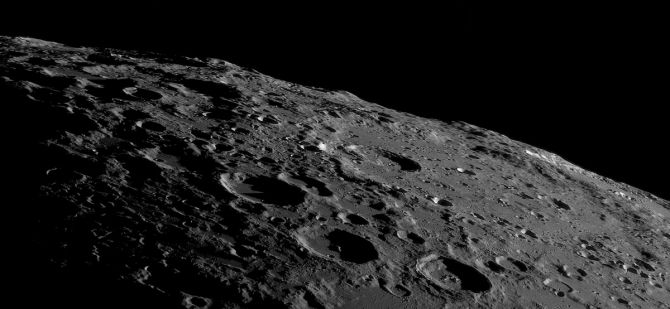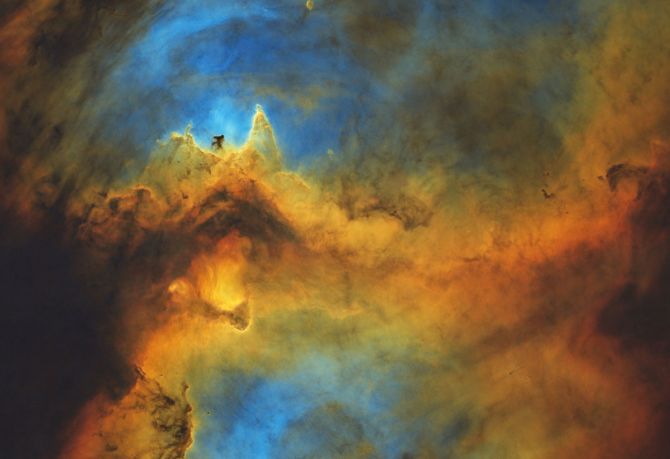The Royal Observatory Greenwich has announced the shortlisted images for the 2022 Astronomy Photographer of the Year!
The Awe-Inspiring scenes of the Milky Way rising, galaxies colliding, stellar nurseries, the luminous Aurora Borealis dancing across the night's sky and Saturn balanced by its moons all feature in this shortlist for this year's Astronomy Photographer of the Year award.

The shortlisted images from this year's competition include the Harvest Moon rising behind Glastonbury Tor in the United Kingdom, the lights of the Milky Way mirrored by the highest national highway in the world in Tibet, one of the most detailed amateur-produced maps of the lunar south pole, created in the United States, a partial solar eclipse over Italy, and the Southern Pinwheel Galaxy captured in Australia exactly 270 years after its discovery.
Let's take a look at some of the images according to the competition categories, in addition to the Overall winner of the Astronomy Photographer of the Year 14.
Circles and Curves by Sean Goebel

Viewed from under a quadruple arch, the stars circle around Polaris, in this stack of 33 four-minute exposures. California's Sierra Nevada mountain range fills the horizon and Mount Whitney, the tallest peak in the continental United States, is on the far left.
Equipment used: Sony ILCE-7RIII camera, 12 mm f/2.8, ISO 2000, 33 x 4-minute exposures
Location: California, USA
Oregon Coast by Marcin Zajac

The Milky Way above the southern Oregon coast, USA. This location is notoriously foggy during the summer, which makes it challenging to shoot the Milky Way here.
Equipment used: Nikon D800 camera, 35mm f/2, ISO 800, 4-minute exposure.
Location: Oregon, USA
NGC 6888 -- The Crescent Nebula by Bray Falls

A deep view of the Crescent Nebula in Cygnus, the result of shockwaves originating from the Wolf--Rayet star WR 134.
This is a bicolour narrowband image with RGB stars.
The nebula details were created from a false bicolour narrowband combination of H-alpha and OIII, and the star colours were added from a natural RGB image.
All exposures were captured with a high-frequency AO guider at a very high resolution (0.2"/pixel), requiring great seeing.
Equipment used: A ZWO-ASI6200MM-Cool camera, 3654 mm f/9, 45 hours of 10-minute exposures.
Location: Auberry, California, USA
The Starry Sky Over the World's Highest National Highway by Yang Sutie

The illuminated National Highway 219, the highest national highway in the world, snakes through the foreground, almost mirroring the majestic image of the Milky Way above.
The two are separated by Kula Kangri, a mountain located in Shannan Prefecture, Tibet..
Equipment used: SIGMA ILCE-1 camera, 20 mm f/2.8, ISO 800, 245-second total exposure.
Location: Shannan, Tibet, China
Moonrise Over Los Angeles by Sean Goebel

An alignment of the Moon, mountain and iconic skyline of Los Angeles following a winter storm on 18 December 2021.
Equipment used: Sony ILCE-7M3 camera, 324 mm f/8, ISO 200, 1/60-second exposure.
Location: Los Angeles, California, USA
Equinox Moon and Glastonbury Tor by Hannah Rochford

Sigma 150--600 mm telescope, SLIK tripod, Canon EOS 5D Mark II camera, 600 mm f/6.37, 1/8-second exposure
Equipment used: SIGMA ILCE-1 camera, 20 mm f/2.8, ISO 800, 245-second total exposure.
Location: Glastonbury, Somerset, UK
Spectrum by Stefan Liebermann

The Northern Lights over the famous Icelandic mountain, Vestrahorn.
A panorama of three photos, processed with Lightroom and Photoshop.
Equipment used: Sony ILCE-7SM3 camera, 14 mm f/1.8, 2-second exposure.
Location: Vestrahorn, Iceland
An Icelandic Saga by Carl Gallagher

The photographer went on a nine-day, 2500-mile road trip, chasing gaps in the clouds, to capture the Aurora Borealis above the wreck of the Gardur in the Westfjords region of Iceland.
Equipment used: Canon 6D Mark II camera, 24mm f/2, ISO 400, 10-second exposure.
Location: Patreksfjörður, Westfjords, Iceland.
Cosmic Collision by Mark Hanson, Mike Selby

NGC 5426 and NGC 5427 are two spiral galaxies of similar size engaged in a major interaction.
Known collectively as Arp 27, the interaction is expected to continue for tens of millions of years.
Equipment used: CDK 1000 telescope, FLI 16803 camera,6000 mm f/6, 32 hours total exposure. RGB values were captured using RiDK 700 FL 4900 telescope.
Location: El Sauce Observatory, Río Hurtado, Coquimbo Region, Chile
Hydra's Pinwheel by Peter Ward

Nicolas-Louis de Lacaille first observed what later became known as the Southern Pinwheel Galaxy on 23 February 1752 from the Cape of Good Hope, South Africa.
This image, taken exactly 270 years later, combines a deep set of H-alpha exposures along with colour data to highlight the ruby-like star-forming regions of this beautiful barred spiral galaxy.
Equipment used: SBIG STX-16803 and QHY 600M cameras, at 3400 mm f/8, exposure of 5 hours (H-alpha) and 6 hours (RGB)
Location: Barden Ridge, New South Wales, Australia.
Fly over the South Pole by Andrea Vanoni

Due to favourable libration, in this image, you can see the craters and mountains at the lunar south pole, including the crater Bailly (with its discernible basin) on the right.
Under Bailly are the craters Bettinus, Kircher and Wilson.
The Montes Leibnitz are visible on the edge.
Equipment used: ZWO ASI178MM camera, Newton 405mm 'Ares' f/4.5 and Barlow 2.7x lens.
Location: Porto Mantovano, Lombardy, Italy.
Solar Inferno by Stuart Green

The Sun looks different every time astrophotographers capture an image as new sunspots form, grow and eventually fade away.
The photographer selectively filtered out all wavelengths of light except a narrow red band (known as the H-alpha line) to reveal an active region of change of the Sun.
Equipment used: Basler acA1920-155um camera, 5100 mm f/34, 2,500 x 0.02-second exposures (50-second total exposure). Using a home-built telescope fitted with a Lunt 35 H-alpha etalon filter.
Location: Preston, Lancashire, UK.
The Jovian Family by Damian Peach

Jupiter captured with three of its largest moons.
The famous Great Red Spot is visible on Jupiter itself, along with many other spots and storms.
Similar details are also visible on all three of the Jovian moons.
The bright ray crater Osiris can be seen clearly on Ganymede at the upper left.
Equipment used: ZWO ASI174MM camera, multiple video frames.
Location: Río Hurtado, Coquimbo, Chile
Comet C/2021 A1 (Leonard) by Lionel Majzik

Comet Leonard was discovered by G.J. Leonard on 3 January 2021 and made its closest pass to Earth on 12 December 2021.
The photographer secured some time with the robotic telescope at the Skygems Remote Observatories in Namibia on 27 December to capture this rare glimpse of a comet that will leave the Solar System and not be seen again.
Equipment used: QHY 600M camera, 600 mm f/3, 2 x 120-second exposures (Lum), 1 x 120-second exposure (RGB).
Location: Hakos, Khomas, Namibia
Busy Star by Sergio Díaz Ruiz

This image depicts the busy surface and coronal activity of the Sun at 22:08 Universal Time on 15 February 2022.
A powerful Coronal Mass Ejection (CME), shown in deep red in the upper left corner, erupted on the far side.
Intriguing formations of plumes (in blue), coronal holes (in dark teal) and filaments (brown) are also represented.
To capture all this activity in one image, it was necessary to combine observations in multiple wavelengths in the extreme ultraviolet.
Equipment: Used open source data from NOAA GOES-16, Solar Ultraviolet Imager (SUVI).
Radio Telescope by Liu Xuemei

The Mingantu Astronomical Observatory is in the Inner Mongolia Autonomous Region of China and is mainly used to observe the Sun.
Here, it is silhouetted against a starry night sky.
Equipment: Nikon D810A camera, 35 mm f/4, 120-second total exposure.
Location: Mingantu Town, Zhengxiangbai Banner, Inner Mongolia Autonomous Region, China
A Little Devil Riding on the Head of a Dragon by Nan Wang, Binyu Wang.

This image shows the nebula IC 1848 and its core, IC 1871.
The Soul Nebula is an emission nebula located in Cassiopeia.
In the east of the Soul star cloud there is a complex of nebulae and star clusters known as the Heart Nebula (IC 1805) of nebula and star cluster.
Together they are often referred to the 'Heart and Soul'.
Equipment used: ZWO ASI6200MM PRO camera, 1100 mm f/7.3, 32-hour total exposure.
Location: Enjoy Observatory, China
Pickering's Triangle in Light-Polluted City by Zezhen Zhou

Growing light pollution in cities is one of the major challenges faced by astrophotographers. Only some of the very brightest stars can be seen through pollution.
Zezhen Zhou used narrow bandpass filters to capture this image of NGC 6979 (Pickering's Triangle) in Shaoxing, China.
Equipment used: SONY IMX533 and ZWO ASI533MC PRO cameras, 714mm f/7, 6-hour total exposure.
Location: Keqiao, Shaoxing, Zhejiang Province, China.
The winners of the competition's nine categories, two special prizes and the overall winner will be announced at a special online award ceremony on Thursday, September 15.
The winning images will be displayed in an exhibition at the National Maritime Museum from Saturday, September 17, alongside a selection of exceptional shortlisted images.
Photographs curated by Rajesh Karkera/Rediff.com
Feature Presentation: Ashish Narsale/Rediff.com











 © 2025
© 2025